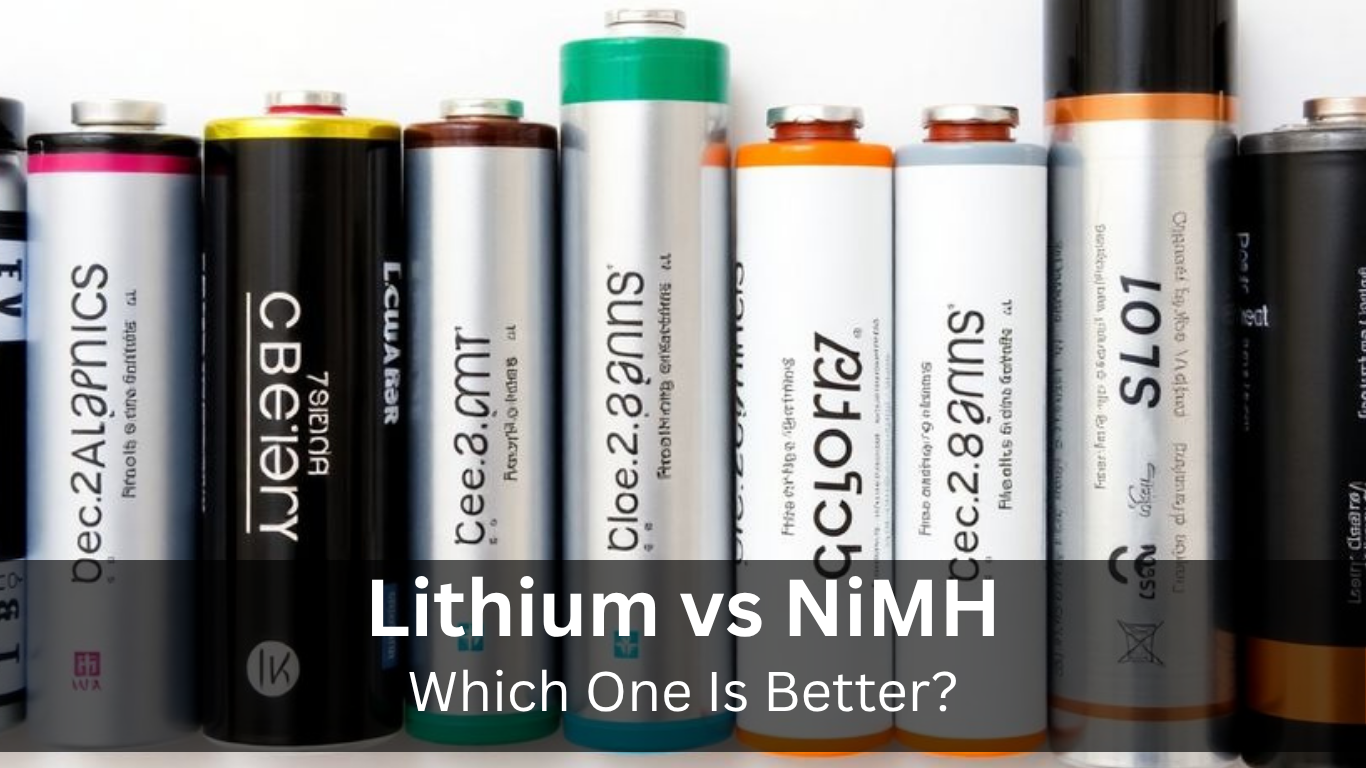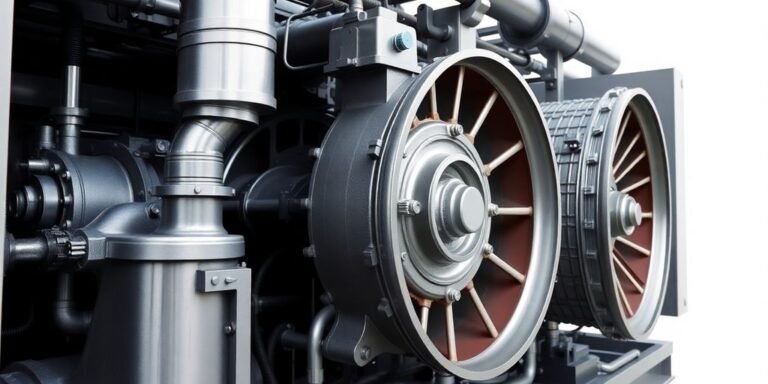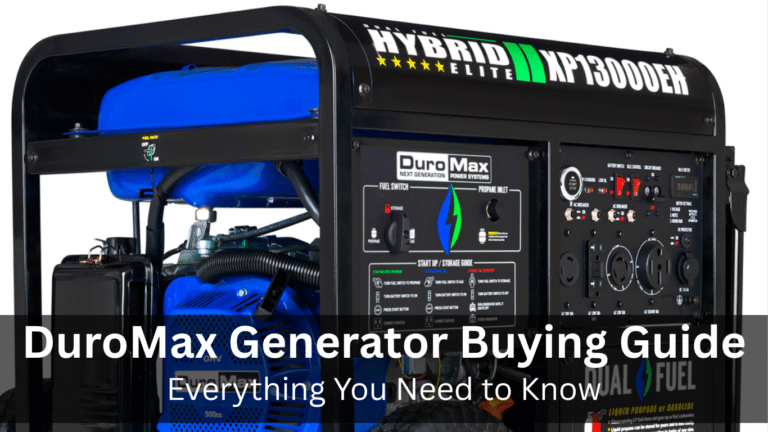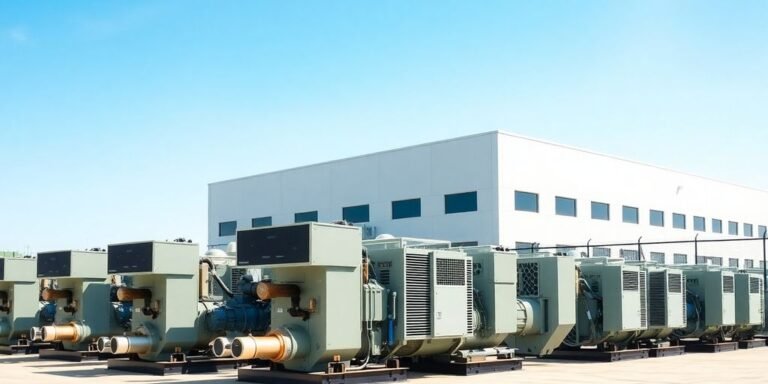Lithium vs NiMH Batteries: Which One Is Better?
Ever wondered about the power behind your gadgets? We often hear about different battery types, but two common ones are lithium and NiMH. Both are rechargeable, but they work pretty differently. Knowing how they stack up can help you pick the right one for your stuff, whether it’s a remote control or something bigger. This article will break down the main points of lithium vs nimh batteries, so you can see which one might be better for your needs.
Key Takeaways about Lithium vs NiMH
- NiMH batteries are generally cheaper and less harmful to the environment, but they hold less power and wear out faster.
- Lithium-ion batteries pack more energy, last longer, and are common in modern electronics like phones and laptops.
- Lithium-ion batteries have a higher voltage per cell, meaning fewer cells are needed for the same power output, making devices smaller and lighter.
- NiMH batteries are safer in terms of overheating risks, while lithium-ion batteries require more careful thermal management.
- The best battery choice depends on the specific use: NiMH for simple, low-power devices, and lithium-ion for high-performance, long-lasting applications.
Understanding NiMH Batteries
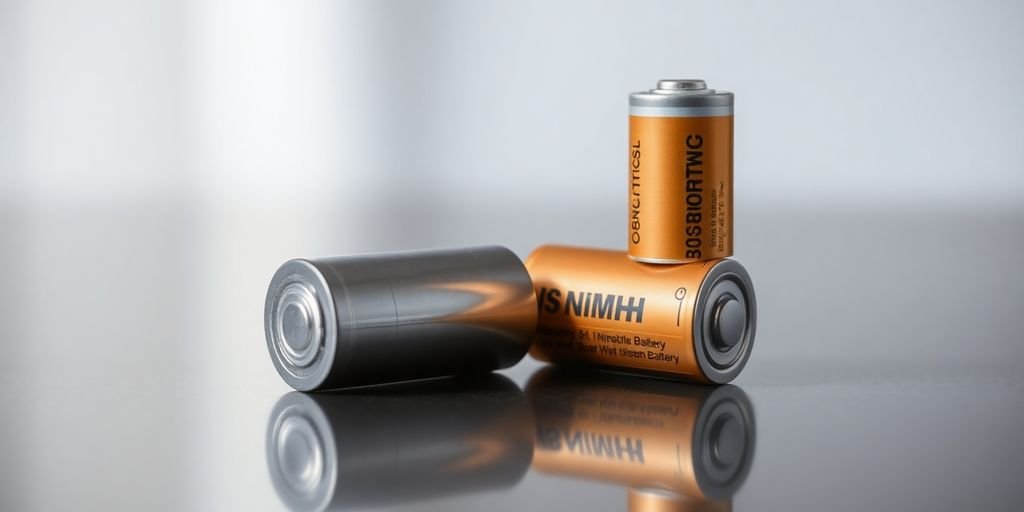
Defining Nickel-Metal Hydride Technology
Nickel-Metal Hydride (NiMH) batteries are a type of rechargeable battery that have been around for a while. They’re known for being a step up from older Nickel-Cadmium (NiCd) batteries, offering better energy density and being kinder to the environment. At their core, NiMH batteries use a hydrogen-absorbing alloy for the negative electrode and nickel oxide hydroxide for the positive electrode.
Think of them as a reliable, if somewhat outdated, workhorse in the battery world. They’re not the flashiest, but they get the job done in many situations. The voltage of each NiMH battery cell is 1.25V.
Common Applications of NiMH Batteries
You’ll find NiMH batteries in a bunch of everyday devices. They’re commonly used in:
- Household electronics like remote controls.
- Cordless phones (if you still have one!).
- Digital cameras, especially older models.
- Hybrid vehicles, often working alongside other battery technologies.
NiMH batteries are a reliable choice for devices that need a consistent, moderate amount of power. They can also handle a bit of abuse, like overcharging, without failing catastrophically. They are not usually the best battery type for high-drain electronics lithium or NiMH, but they are still useful.
Advantages and Disadvantages of NiMH
NiMH batteries have their pros and cons. Here’s a quick rundown:
Advantages:
- More affordable than lithium-ion batteries.
- Safer under physical or thermal stress.
- Easier to recycle compared to some other battery types.
Disadvantages:
- Bulkier and heavier than lithium-ion batteries.
- Higher self-discharge rate, meaning they lose charge faster when not in use.
- Shorter lifespan than lithium-ion batteries.
NiMH batteries are a solid choice for basic, everyday applications where cost and safety are bigger concerns than size or lifespan. They might not be the most exciting technology, but they’re dependable and readily available.
Exploring Lithium-Ion Batteries
Defining Lithium-Ion Technology
Lithium-ion (Li-ion) batteries have become a staple in modern technology. They work by using lithium ions to move between the anode and cathode, facilitating the flow of electrical current. Electrolyte solutions are used to help the movement of ions. Unlike older battery technologies, Li-ion batteries don’t suffer from the “memory effect,” meaning you don’t have to fully discharge them before recharging. This makes them incredibly convenient for everyday use.
Widespread Use of Lithium-Ion Batteries
Li-ion batteries are everywhere! You’ll find them in:
- Smartphones and laptops
- Electric vehicles (EVs)
- Power tools
- Medical devices
- Aerospace applications
Their high energy density and relatively light weight make them ideal for portable devices and applications where weight is a concern. The advancements in battery technology powering the future are largely driven by the need for better Li-ion batteries.
Benefits and Drawbacks of Lithium-Ion
Li-ion batteries have a lot going for them, but they aren’t perfect. Here’s a quick rundown:
Pros:
- High energy density
- Low self-discharge rate
- Relatively long lifespan (depending on usage)
- No memory effect
Cons:
- Can be more expensive than other battery types
- Potential safety concerns (overheating, fire risk)
- Degradation over time, even when not in use
- Environmental concerns related to mining materials like lithium and cobalt
Despite the drawbacks, Li-ion batteries remain a dominant force in the battery market due to their superior performance in many key areas. Ongoing research and development are focused on addressing the safety and environmental concerns, as well as improving the lifespan and reducing the cost of these batteries.
Key Performance Metrics: Lithium vs NiMH Batteries
Comparing Energy and Power Density
Okay, let’s get into the nitty-gritty of what makes these batteries tick. When we talk about energy density, we’re looking at how much oomph a battery can pack into a certain size or weight. Lithium-ion batteries are the clear winners here. They can store way more energy for their size compared to NiMH. Power density? That’s how quickly a battery can dish out that energy. Again, lithium-ion usually takes the lead, meaning they can deliver a lot of power fast, which is great for things like power tools or electric vehicles. NiMH, while not as impressive, still holds its own for less demanding applications.
Charge and Discharge Rate Differences
Charge and discharge rates are super important. Lithium-ion batteries generally have faster charge and discharge rates. This means they can charge up quicker and deliver power more rapidly than NiMH batteries. NiMH batteries have moderate charge/discharge rates, but pushing them too hard can shorten their lifespan. Think about it like this: lithium-ion is like that friend who’s always ready to go, while NiMH is more of a slow and steady type.
Voltage and Capacity Comparison
Voltage and capacity are also key factors. A single NiMH cell typically has a voltage of 1.2V, while a lithium-ion cell rocks around 3.6V. This means you often need fewer lithium-ion cells to achieve the same voltage as a NiMH setup. Capacity, measured in mAh (milliampere-hours), tells you how long a battery can deliver a certain amount of current. While NiMH cells can sometimes boast higher mAh ratings, the higher voltage of lithium-ion often translates to better overall performance. It’s not just about the numbers; it’s how they work together. Let’s take a look at a quick comparison:
| Feature | NiMH | Lithium-Ion |
|---|---|---|
| Cell Voltage (V) | 1.2 | 3.6 |
| Energy Density | Lower | Higher |
Choosing between lithium and NiMH rechargeable batteries really boils down to what you need the battery for. If you need something that can deliver a lot of power quickly and doesn’t weigh much, lithium-ion is the way to go. But if you’re on a budget or need something for low-drain devices, NiMH can still be a solid choice. Considering lead-acid and lithium-ion batteries is also important.
And what about which lasts longer lithium or NiMH batteries? Well, that depends on usage patterns and how well you take care of them. But generally, lithium-ion tends to have a longer lifespan, especially with proper charging and discharging habits. Also, don’t forget to consider lithium vs NiMH battery performance in cold weather if you live in a colder climate. Finally, are lithium batteries worth the cost over NiMH? That’s something you’ll have to decide based on your specific needs and budget.
Durability and Lifespan Considerations
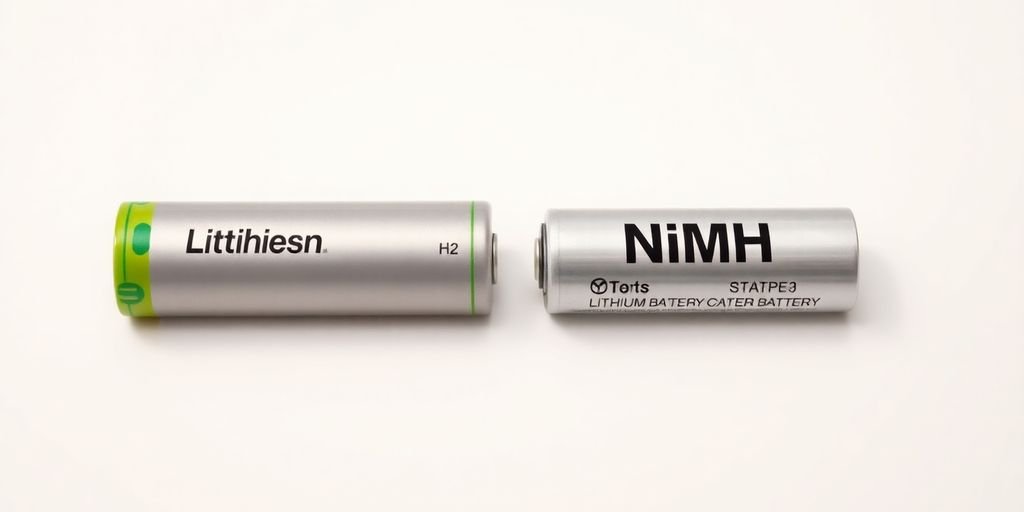
Cycle Life of Lithium-Ion vs NiMH
When it comes to how many times you can charge and discharge a battery before it starts to lose its oomph, there’s a clear winner. Lithium-ion batteries generally offer a significantly longer cycle life compared to NiMH batteries. You’re often looking at over 2000 cycles for lithium-ion, while NiMH might give you something in the range of 500 to 1000 cycles. This means a device powered by lithium-ion will likely last longer before the battery needs replacing. This is a big deal for things like electric vehicles or power tools that get used a lot. The battery cycle life is an important factor to consider.
Self-Discharge Rates Explained
Self-discharge is how quickly a battery loses its charge when it’s just sitting around, not being used. NiMH batteries have a higher self-discharge rate than lithium-ion. This means if you leave a NiMH battery in a drawer for a month, it’ll lose a noticeable amount of its charge. Lithium-ion batteries, on the other hand, hold their charge much better. Here’s a quick comparison:
- NiMH: Loses about 15-30% of its charge per month.
- Lithium-ion: Loses only about 2-3% of its charge per month.
- This difference is important for devices that aren’t used regularly.
- Consider the environmental footprint of each battery type.
Longevity Expectations for Each Battery Type
Okay, so how long can you expect these batteries to last in real-world use? Well, it depends on a bunch of factors, like how often you use them, how you charge them, and the temperature they’re exposed to. But, in general, lithium-ion batteries tend to have a longer lifespan. NiMH batteries might last for 2 to 5 years, while lithium-ion batteries can often go for 5 years or more. Of course, improper handling, like extreme temperatures or overcharging, can shorten the lifespan of either type. It’s worth noting that even when stored, lithium-ion batteries can degrade slowly over time, which may impact longevity if left unused for extended periods.
It’s important to remember that these are just general guidelines. The actual lifespan of a battery can vary quite a bit depending on the specific brand, model, and usage patterns. Always follow the manufacturer’s recommendations for charging and storage to maximize the lifespan of your batteries.
Safety and Environmental Impact
Thermal Stability and Overheating Risks
Okay, so let’s talk safety. When it comes to batteries, things can get a little spicy, literally. Both NiMH and lithium-ion batteries have their own set of potential problems. NiMH batteries are generally pretty stable, but lithium-ion batteries? They can be a bit more temperamental. The big concern with lithium-ion is something called thermal runaway, which is basically a fancy way of saying the battery can overheat and potentially catch fire.
To prevent overheating, engineers add additives or use flame-retardant materials when designing batteries. For example, electric vehicles add liquid coolant.
Environmental Footprint of Battery Production
Now, let’s get into the nitty-gritty of how these batteries affect our planet. Making batteries isn’t exactly a walk in the park for the environment. Think about it: you’ve got to dig up all sorts of materials, process them, and then put everything together. All that takes energy and resources. Extracting and processing nickel for NiMH batteries can lead to water contamination and greenhouse gas emissions. Lithium-ion batteries aren’t innocent either; mining lithium and cobalt can cause soil degradation and water pollution. The production of both types of batteries involves refining metals, manufacturing electrodes, and assembling cells, all of which contribute to greenhouse gas emissions and waste disposal issues.
Recycling and Disposal Considerations
So, what happens when these batteries reach the end of their lives? Can we just toss them in the trash? Nope, definitely not. Improper disposal can lead to some serious environmental problems. The good news is that both NiMH and lithium-ion batteries can be recycled, but it’s not always easy.
- NiMH recycling involves separating metals like nickel, which can be tricky.
- Lithium-ion recycling is becoming more common, but the sheer volume of batteries is a challenge.
- Improvements in recycling processes are helping to recover valuable metals from both types of batteries.
Recycling is key, but it’s not a perfect solution. We need better ways to handle the growing mountain of used batteries to minimize their impact on the environment. This includes improving recycling technologies and encouraging responsible disposal practices.
Cost and Market Dominance
Initial Purchase Price Comparison
Okay, let’s talk money. Upfront, NiMH batteries usually win the price war. You can often find them cheaper than lithium-ion options, especially when you’re just buying a few for things like remote controls or toys. Lithium-ion batteries tend to have a higher initial purchase price because of the more complex manufacturing processes and the materials involved. Think of it like this: NiMH is like buying a regular coffee, while lithium-ion is like opting for a fancy latte – both give you a boost, but one costs more.
Long-Term Value and Efficiency
But hold on, the initial price isn’t the whole story. When you look at the long haul, lithium-ion batteries can actually be more cost-effective. They typically last longer, offering more charge cycles than NiMH. This means you won’t have to replace them as often, saving you money in the long run. Plus, lithium-ion batteries generally have a higher energy density, so they can power devices for longer on a single charge. It’s like buying a more efficient appliance – you pay more at first, but it saves you on energy bills over time. Consider these points:
- Lithium-ion batteries often have a longer lifespan.
- They provide more consistent power output.
- Fewer replacements mean less waste and lower long-term costs.
It’s important to consider the total cost of ownership, not just the initial price tag. Factors like lifespan, energy efficiency, and replacement frequency all play a role in determining which battery type offers the best value over time.
Market Trends and Industry Adoption
Right now, lithium-ion batteries are dominating the market, and it’s not hard to see why. They’re in everything from smartphones and laptops to electric vehicles and power tools. This widespread adoption has led to increased production and, in some cases, lower prices. In 2024, lithium-ion batteries held a significant market share. NiMH batteries still have their place, especially in applications where cost is a major concern or where high energy density isn’t necessary, but lithium-ion is definitely the frontrunner. The reasons for lithium-ion batteries’ market dominance include:
- High energy density
- Lightweight design
- Fast charging speeds
Optimal Applications for Each Battery Type
Best Uses for NiMH Batteries
NiMH batteries really shine in applications where you need a reliable power source without breaking the bank. Think about devices that don’t demand super high energy density but still need decent performance. For example:
- Remote-controlled toys: NiMH batteries are a solid choice because they offer a good balance of cost and performance. Kids can play without you constantly swapping out batteries.
- Flashlights: For everyday flashlights, NiMH batteries provide dependable power. They might not last as long as lithium-ion, but they’re more affordable to replace.
- Hybrid electric vehicles: NiMH batteries have been used in hybrid cars for years, offering a cost-effective solution for regenerative braking and supplemental power. You can find hybrid electric vehicles using this technology.
NiMH batteries are also great for devices that require a standard battery size, like AA or AAA, making them easy to swap and replace. They’re a practical choice for many household gadgets.
Ideal Applications for Lithium-Ion Batteries
Lithium-ion batteries are the go-to choice when you need high energy density and lightweight design. They dominate the portable electronics market for a reason. Here’s where they excel:
- Smartphones and laptops: The compact size and high energy density of lithium-ion batteries make them perfect for these devices.
- Electric vehicles (EVs): EVs rely on lithium-ion batteries for their long range and quick charging capabilities. The higher energy density allows for more miles per charge.
- Power tools: Cordless drills, saws, and other power tools benefit from the high power output and lightweight design of lithium-ion batteries. This makes them easier to handle and use for extended periods.
Choosing the Right Battery for Specific Needs
Selecting between NiMH and lithium-ion batteries really comes down to what you need the battery for. Consider these factors:
- Energy needs: If you need high energy density and long run times, lithium-ion is the way to go. For less demanding applications, NiMH batteries are often sufficient.
- Budget: NiMH batteries are generally cheaper upfront. If cost is a major concern, they’re a good option. However, lithium-ion batteries might offer better long-term value due to their longer lifespan and better performance. Consider the battery replacements you might need.
- Weight and size: Lithium-ion batteries are lighter and more compact, making them ideal for portable devices. If weight and size are critical, lithium-ion is the better choice.
Ultimately, understanding the strengths and weaknesses of each battery type will help you make the best decision for your specific application. Think about what matters most – power, cost, weight, or longevity – and choose accordingly. Also, consider the cycle life of the battery.
Conclusion
So, when it comes to picking between NiMH and lithium-ion batteries, there’s no single “best” choice for everyone. It really just depends on what you need it for. NiMH batteries are often cheaper and can be a good fit for things like remote controls or toys, where you don’t need a ton of power or super-fast charging. But if you’re looking for something that packs a punch, charges up quick, and lasts a long time, lithium-ion is probably your go-to.
Think phones, laptops, or even electric cars. Both types have gotten better over time, with new tech making them safer and more efficient. Ultimately, it’s about matching the battery to the job. What works great for one gadget might not be the right fit for another.
Frequently Asked Questions
Can I charge a NiMH battery with a Li-ion charger?
No, you shouldn’t use a charger made for Li-ion batteries with a NiMH battery. These two types of batteries work very differently. Using the wrong charger can be dangerous and damage the battery. Always use the charger that’s designed for your specific battery type.
Which is better for energy storage: Li-ion or NiMH batteries?
When it comes to energy storage, Li-ion batteries are much better. NiMH batteries tend to lose their charge pretty quickly when they’re not being used, which is called a high self-discharge rate. Li-ion batteries, on the other hand, can hold their charge for a much longer time, making them more efficient for storing energy.
Which type of rechargeable battery lasts the longest?
Generally, Li-ion batteries last longer. They have a very low self-discharge rate, meaning they don’t lose much power when not in use. They can also handle many more charge and discharge cycles—sometimes up to 4,000 cycles, which could mean 10 years of use. NiMH batteries usually last about 3 years.
Is NiMH safer than Lithium-ion?
NiMH batteries are generally considered safer because they are less likely to overheat or catch fire if something goes wrong. However, they can still have issues if they get too hot. Li-ion batteries are more sensitive to temperature changes, but they have safety features built in to prevent problems. Both types are safe when used correctly.
Are Li-ion and NiMH batteries the same?
No, Li-ion and NiMH batteries are not the same and cannot be swapped out for each other. Even though both are rechargeable and power many common devices, they have different chemical makeups. Li-ion batteries are used in a wider range of gadgets because they offer more power.
What does NiMH mean on a battery?
NiMH stands for Nickel-Metal Hydride. These are common rechargeable batteries often found in small portable devices, remote controls, and power tools. They’re special because their inside parts are made from materials that can soak up hydrogen, which makes them very good at storing energy.

